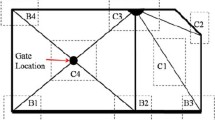Abstract
The work focuses on experimental examination of the fatigue behavior of magnesium alloy AZ31 produced by three different procedures: squeeze casting (SC), hot rolling (HR), and equal-channel angular pressing (ECAP). The microstructures produced were studied by light and transmission electron microscopy (TEM). Squeeze-cast AZ31 had low porosity and coarse grains, while hot-rolled material showed microstructure with grain size of 3 to 20 μm. The finest grain structure with the average grain size of about 1 to 2 μm was found in the material pressed 4 times at 200 °C using the ECAP technique, route B c . It was shown that low- and high-cycle fatigue behavior under symmetric loading at room temperature and with loading frequency of 20 Hz is strongly dependent on the technique employed in producing the alloy. The ECAP was shown to improve the fatigue life of the material in the low-cycle region over that of the squeeze-cast material. However, the fatigue life of AZ31 after ECAP was slightly lower than that of the hot-rolled material. In the high-cycle region, the hot-rolled material and the material that underwent ECAP exhibit the same fatigue strength, which is superior to that of the squeeze-cast alloy. Fatigue crack initiation and the character of fracture were examined by means of scanning electron microscopy.








Similar content being viewed by others
Notes
PHILIPS is a trademark of Philips Electron Instruments Corp., Mahwah, NJ.
JEOL is a trademark of Japan Electron Optics Ltd., Tokyo.
References
Ho-Kung Kim, Y.-I. Lee, and Chin-Sung Chung: Scripta Mater., 2005, vol. 52, pp. 473–77
K. Ishikawa, H. Watanabe, and T. Mukai: J. Mater. Sci., 2005, vol. 40, pp. 1577–82
O.B. Kulyasova, R.K. Islamgaliev, and N.A. Krasilnikov: Mater. Sci. Forum, 2006, vols. 503–504, pp. 609–14
A. Yamashita Z. Horita, and T.G. Langdon: Mater. Sci. Eng., 2001, vol. A300, pp. 142–47
Chin-Sung Chung, Duk-Kyu Chun, and Ho-Kyung Kim: J. Mech. Sci. Technol. (KSME Int. J.), 2005, vol. 19, pp. 1441–48
T.T. Lamark R.J. Helmig, and Y. Estrin: Mater. Sci. Forum, 2006, vols. 503–504, pp. 889–94
H. Somekawa and T. Mukai: Scripta Mater., 2006, in press
W.J. Kim, and H.T. Jeong: Mater. Trans., 2005, vol. 46, pp. 251–58
Y. Estrin, R.J. Hellmig, M. Janeček, T.T. Lamark, Z. Zúberová, R. Lapovok, and M.V. Popov in: Ultrafine Grained Materials IV., Y.T. Zhu, T.G. Langdon, Z. Horita, M.J. Zehetbauer, S.L. Semiatin, and T.C. Lowe (eds)., TMS, Warrendale, PA, 2006, pp. 381–88
R. Lapovok, P.F. Thomson, R. Cottam, and Y. Estrin: J. Mater. Sci., 2005, vol. 40, pp. 1699–1708
M. Mabuchi, H. Iwasaki, and K. Higashi: Mater. Sci. Forum, 1997, vols. 243–245, pp. 547–52
T. Mukai, M. Yamanoi, H. Watanabe, and K. Higashi: Scripta Mater., 2001, vol. 45, pp. 89–94
S.R. Agnew J.A. Horton T.M. Lillo, and D.W. Brown: Scripta Mater., 2004, vol. 50, pp. 377–81
Y. Estrin, S.B. Yi, H.-G. Brokmeier, Z. Zuberova, S.C. Yoon, H.S. Kim, and R.J. Hellmig: Int. J. Mater. Res, in press.
A. Beck: Magnesium und Seine Legierungen, Verlag von Julius Springer, Berlin, 1939
H. Mayer, M. Papakyriacou, B. Zettl, and S.E. Stanzl-Tschegg: Int. J. Fatigue, 2003, vol. 25, pp. 245–56
Acknowledgments
Hot-rolled material was kindly provided by Professor B. Engl (MgF2, Freiberg). Partial support of this work from DAAD (Germany) and AVCR (Czech Republic) under Grant No. DAAD-AVCR D8-CZ5/06-07 is gratefully acknowledged. One of the authors (LK) also acknowledges support from the Ministry of Education of the Czech Republic through Grant No. 1P05ME804.
Author information
Authors and Affiliations
Corresponding author
Additional information
This article is based on a presentation made in the symposium entitled “Ultrafine-Grained Materials: from Basics to Application,” which occurred September 25–27, 2006 in Kloster Irsee, Germany.
Rights and permissions
About this article
Cite this article
Zúberová, Z., Kunz, L., Lamark, T. et al. Fatigue and Tensile Behavior of Cast, Hot-Rolled, and Severely Plastically Deformed AZ31 Magnesium Alloy. Metall Mater Trans A 38, 1934–1940 (2007). https://doi.org/10.1007/s11661-007-9109-6
Published:
Issue Date:
DOI: https://doi.org/10.1007/s11661-007-9109-6




